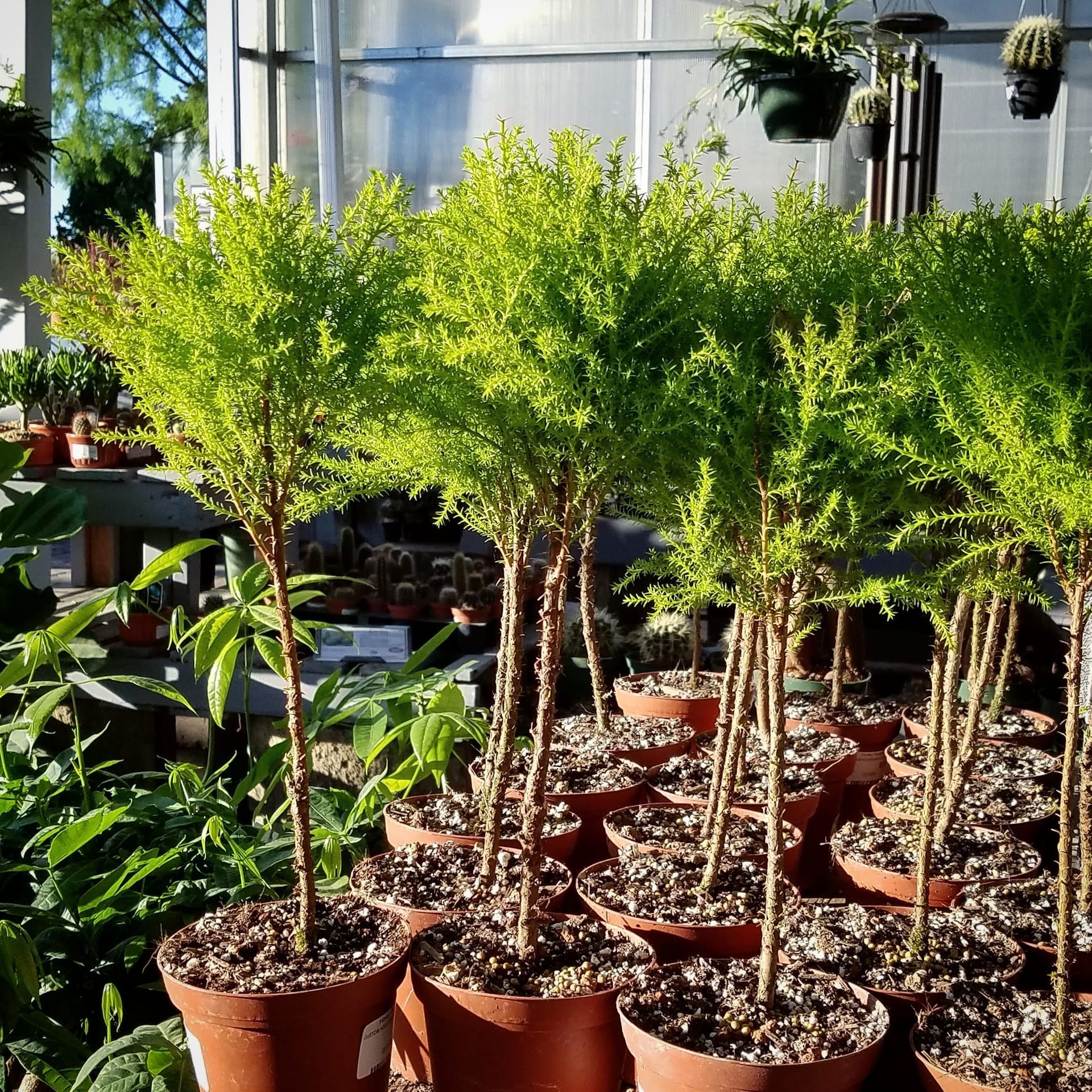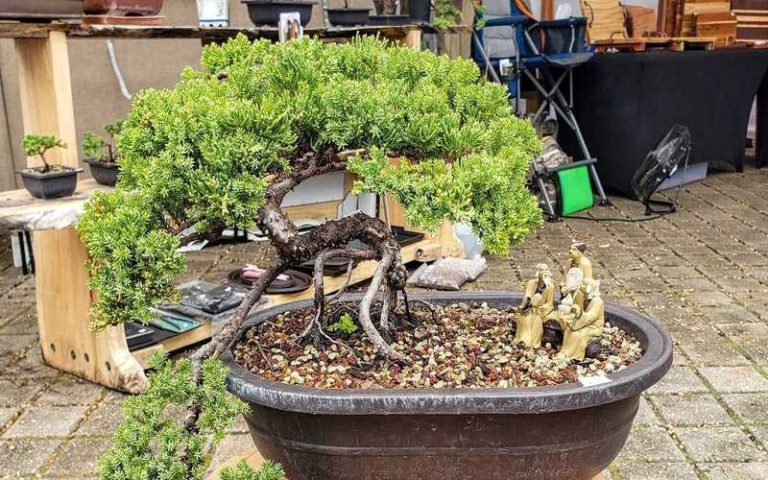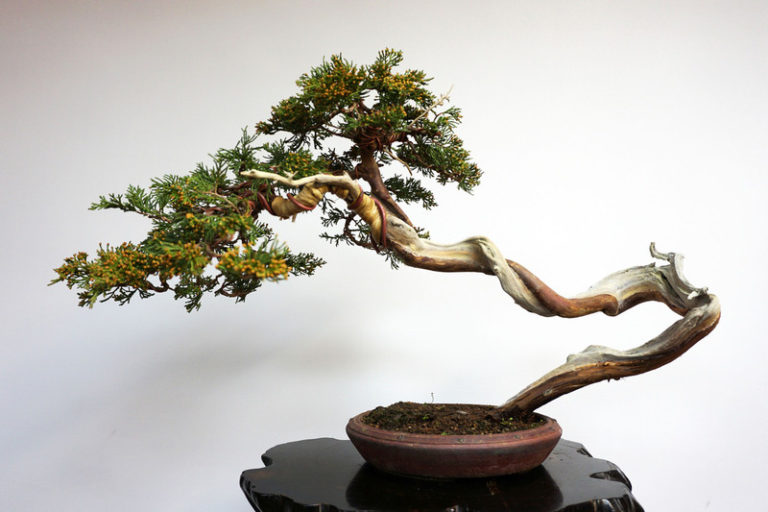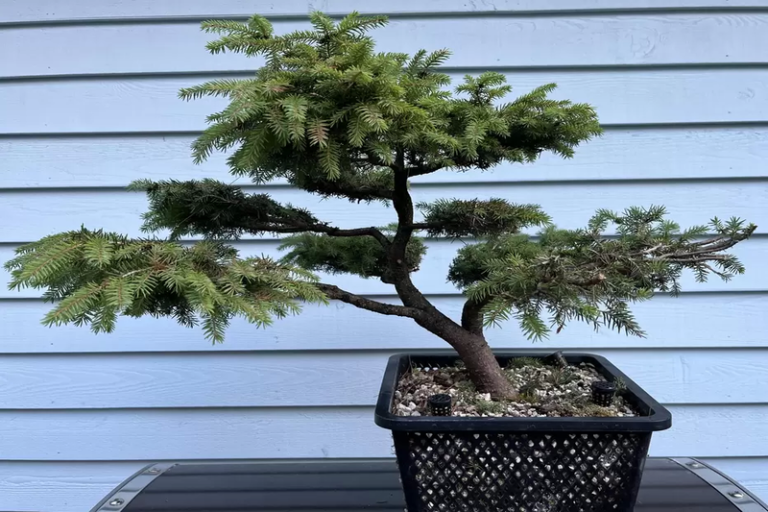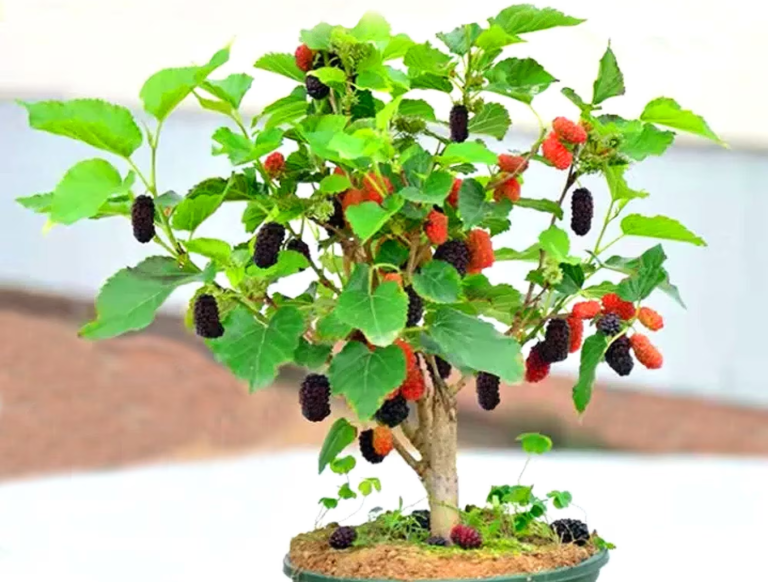Lemon Cypress Bonsai : A Refreshing Twist on a Classic Bonsai Tree
Lemon Cypress Bonsai is a beautiful and popular choice for bonsai enthusiasts. Bonsai is an ancient Japanese art form of growing trees in miniature sizes. Lemon Cypress Bonsai is a small, evergreen tree that has a lemon scent and looks great in a small pot.
What is Lemon Cypress Bonsai?
Lemon Cypress Bonsai is a miniature version of the lemon cypress tree ( Cupressus macrocarpa ‘Goldcrest’) that is grown using bonsai techniques. Bonsai is an ancient Japanese art form of growing trees in small pots to create a natural, miniature representation of a full-size tree.
Lemon Cypress Bonsai is a little evergreen tree with a lemon smell and vivid green leaves. It is a popular option among bonsai lover due to its distinct look and simplicity of care. Lemon Cypress Bonsai may grow and offer beauty to your house or garden with appropriate care and upkeep.
Types of Lemon Cypress Bonsai
Golden Lemon Cypress Bonsai: This Lemon Cypress Bonsai features vivid yellow leaves and is a popular option because of its distinct and eye-catching look.
Dwarf Lemon Cypress Bonsai: As the name suggests, this type of Lemon Cypress Bonsai is a smaller version of the tree and is ideal for indoor bonsai gardening.
Spiral Lemon Cypress Bonsai: This type of Lemon Cypress Bonsai is pruned and shaped to have a spiral trunk and branches, creating a unique and visually striking appearance.
Conical Lemon Cypress Bonsai: This type of Lemon Cypress Bonsai has a cone-shaped growth habit and is often used in formal bonsai gardens.
Columnar Lemon Cypress Bonsai: This type of Lemon Cypress Bonsai has a tall and narrow growth habit, making it a great choice for small spaces.
Compact Lemon Cypress Bonsai: This type of Lemon Cypress Bonsai has a dense growth habit and is often used in bonsai displays and exhibitions.
Because each form of Lemon Cypress Bonsai has its own distinct characteristics and look, it is essential to select the type that best suits your particular preferences and growing conditions. Whichever variety you pick, Lemon Cypress Bonsai may grow and make a lovely addition to your home or garden with proper care and maintenance.

Lemon Cypress Bonsai and Its Symbolism
Lemon Cypress Bonsai not only adds beauty to your home or garden, but it also has cultural significance and symbolism. In Japan, bonsai trees are considered a symbol of harmony, peace, and balance. The art of growing bonsai trees has been practiced in Japan for centuries and is deeply rooted in Japanese culture.
Lemon Cypress Bonsai, with its fragrant lemon scent and green foliage, is often used as a decorative item in various settings such as weddings, religious ceremonies, and other special occasions. It is also believed to bring good luck and prosperity to its owner.
Apart from its cultural significance, Lemon Cypress Bonsai also has symbolic meanings. In general, bonsai trees represent the balance and harmony between nature and human beings. The miniature trees symbolize the importance of balance, patience, and perseverance in our lives. They also represent the beauty of simplicity and the value of living in the present moment.
Specifically, Lemon Cypress Bonsai represents joy, optimism, and new beginnings. The lemon scent of the tree is believed to have uplifting properties that can help reduce stress and promote positivity. Its bright green foliage symbolizes growth, renewal, and vitality.
Lemon Cypress Bonsai is not only a lovely addition to your house or yard, but it also has cultural and symbolic implications. It denotes joy, optimism, and fresh beginnings, as well as harmony, peace, and balance. Raising and caring for a Lemon Cypress Bonsai may be a gratifying and enjoyable activity that can provide you beauty, happiness, and a feeling of balance.
Characteristics of Lemon Cypress Bonsai
Lemon Cypress Bonsai has several unique characteristics that make it a popular choice for bonsai enthusiasts. Here are some of the key characteristics of Lemon Cypress Bonsai:
Fragrant Lemon Scent: Lemon Cypress Bonsai has a distinctive lemon scent that fills the air around it. This makes it a popular choice for indoor bonsai gardening, as it can provide a refreshing and uplifting fragrance to your home or office.
Bright Green Foliage: Lemon Cypress Bonsai has brilliant green foliage that can give a splash of color to any scene. The needle-like leaves are arranged in a spiral pattern, giving the tree a distinct and eye-catching look.
Evergreen: Lemon Cypress Bonsai is an evergreen tree, which means it has leaves all year. This makes it an excellent choice for indoor bonsai gardening, since it can give beauty and intrigue all year.
Easy to Care For: Lemon Cypress Bonsai is reasonably easy to care for and may thrive in a variety of environments. It enjoys bright, indirect sunshine and soil that drains well. It also needs frequent watering and fertilizing to grow.
Drought Tolerant: Lemon Cypress Bonsai is drought resistant and can endure brief periods of drought. Nonetheless, it is critical to prevent overwatering, which can cause root rot and other issues.
Prunable: Lemon Cypress Bonsai, like other bonsai plants, is highly prable and may be shaped and trained to achieve a desired form. Lemon Cypress Bonsai may be converted into a gorgeous and one-of-a-kind work of art with regular trimming and shaping.
Lemon Cypress Bonsai has a pleasant lemon aroma, vivid green leaves, and is evergreen, simple to care for, drought resistant, and highly prized. These distinguishing features make it a popular choice for bonsai fans seeking a beautiful and easy-to-care-for tree for their indoor or outdoor environment.
How to Grow Lemon Cypress Bonsai
Raising Lemon Cypress Bonsai may be a wonderful and enjoyable experience. Here are some pointers on how to cultivate and care for your Lemon Cypress Bonsai:
- Choose the Right Pot: Select a pot that is somewhat larger than your Lemon Cypress Bonsai’s root ball. To prevent water from pooling at the bottom, the pot should contain drainage holes.
- Soil: Lemon Cypress Bonsai likes well-draining, somewhat acidic soil. A mixture of peat moss, sand, and perlite might provide your tree with an optimal growth habitat.
- Watering: Water your Lemon Cypress Bonsai on a regular basis, but don’t overwater it. Let the top inch of soil to dry before re-watering. Avoid allowing the soil to entirely dry up or allowing the tree to sit in standing water.
- Fertilization: Fertilize your Lemon Cypress Bonsai once a month during the growing season (spring and summer) with a balanced fertilizer. Reduce fertilization in the fall and winter when the tree is dormant.
- Sunlight: Lemon Cypress Bonsai prefers bright, indirect sunlight. Place your tree in a location with ample natural light, but avoid placing it in direct sunlight, as this can cause the leaves to burn.
- Pruning: Prune your Lemon Cypress Bonsai regularly to maintain its desired shape and size. Use sharp, clean pruning shears to remove dead or damaged branches and shape the tree as needed.
- Repotting: Repot your Lemon Cypress Bonsai every two to three years to ensure it has enough room to grow. Repotting should be done in the spring when the tree is actively growing.
By following these simple tips, you can grow a healthy and beautiful Lemon Cypress Bonsai. With proper care and attention, your tree can thrive for many years and provide beauty and enjoyment to your home or garden.
Benefit of Lemon Cypress Bonsai
Lemon Cypress Bonsai is not just a beautiful tree, it also offers several benefits to its owner. Here are some of the benefits of having a Lemon Cypress Bonsai:
Aromatherapy: Lemon Cypress Bonsai has a distinctive lemon scent that can provide aromatherapy benefits to its owner. The scent is refreshing and uplifting, and can help improve mood and reduce stress.
Air Purification: Lemon Cypress Bonsai, like other plants, serves to cleanse the air by eliminating pollutants and poisons. This can result in better indoor air quality and respiratory wellness.
Indoor Decor: Lemon Cypress Bonsai is a lovely and one-of-a-kind addition to any interior environment. Its vivid green leaves and unique design may provide a splash of color and intrigue to any room or workplace.
Relaxation and Meditation: Bonsai gardening may be a peaceful and contemplative pastime that aids in stress reduction and mental health improvement. Taking care of your Lemon Cypress Bonsai may provide you peace and tranquility.
Learning and Creativity: Growing and caring for a Lemon Cypress Bonsai can be a rewarding and educational experience. It can teach you about plant biology, bonsai techniques, and horticulture in general. It can also encourage creativity, as you experiment with shaping and pruning your tree to create unique and beautiful forms.
Lemon Cypress Bonsai offers benefits such as aromatherapy, air purification, indoor decor, relaxation and meditation, and learning and creativity. It is not just a beautiful tree, but a source of joy and well-being for its owner.
Styling and Design for Lemon Cypress Bonsai
Styling and designing your Lemon Cypress Bonsai is a fun and creative process that can make your tree a unique and beautiful addition to your home or garden. Here are some styling and design tips for your Lemon Cypress Bonsai:
- Formal Upright Style: Lemon Cypress Bonsai in the formal upright style are a popular choice. This form has a straight trunk that tapers towards the top, with equally spaced layered and symmetrical branches.
- Informal Upright Style: The casual upright design is more natural and organic, like the appearance of a tree growing in the wild. This type has a slightly curved trunk that tapers towards the top, with unevenly spaced and asymmetrical branches.
- Slanting Style: The slanting style is a striking and eye-catching design that comprises a trunk that slants to one side and branches that grow to the other side. This method may give your Lemon Cypress Bonsai a feeling of movement and vigor.
- Cascade Style: The cascade style is a distinct and eye-catching design that includes a stem that grows downwards and branches that dangle over the edge of the container. This technique may add drama and refinement to your Lemon Cypress Bonsai.
- Broom Style: The broom style is a timeless classic with a straight trunk that spreads out into a symmetrical, circular canopy of foliage. This approach might help your Lemon Cypress Bonsai achieve a feeling of balance and harmony.
Use the natural growth patterns of the tree and work with them to create a unique and attractive look when designing your Lemon Cypress Bonsai. Pruning shears should be used to gently shape and trim your tree, and you should be patient as you work to get the ideal design. Your Lemon Cypress Bonsai may become a gorgeous and one-of-a-kind work of art with time and care.
How to Care and Maintain Lemon Cypress Bonsai
A Lemon Cypress Bonsai is reasonably simple to care for, but it does require regular maintenance to maintain the tree healthy and blooming. Here are some pointers for caring for and maintaining your Lemon Cypress Bonsai:
Watering: Lemon Cypress Bonsai enjoys wet soil, thus it must be watered on a regular basis. Water your tree when the dirt on top seems dry to the touch, but don’t let it become saturated or entirely dry out. Water the tree gently with a watering can or spray bottle, taking care not to damage the soil or leaves.
Light: Lemon Cypress Bonsai enjoys strong, indirect light, so plant it near a window or in a well-lit part of your house or yard. Avoid exposing it to direct sunlight, which can burn and turn the leaves brown.
Temperature: Lemon Cypress Bonsai loves chilly to moderate temperatures ranging from 45 to 65 degrees Fahrenheit (7 to 18 degrees Celsius). Avoid exposing the tree to excessive heat or cold, as this can cause stress and harm.
Fertilizer: Regular fertilization is beneficial to Lemon Cypress Bonsai, especially throughout the growth season. Once every two weeks, apply a balanced liquid fertilizer, or once every three months, use a slow-release fertilizer. Over-fertilization might harm the tree’s roots and cause it to burn.
Pruning: Frequent trimming is required to keep your Lemon Cypress Bonsai in form and size. Sharp pruning shears should be used to clip back any new growth and shape the tree into the desired design. Pruning too much at once might cause the tree to become stressed and wilt or die.
Repotting: Lemon Cypress Bonsai should be repotted every two to three years, or when the roots overflow the pot. Employ a well-draining soil mix and a pot that is somewhat larger than the existing one. Repotting bonsai plants should be done with care since their roots are sensitive and easily injured.
Lemon Cypress Bonsai Care Sheet
| Aspect | Care Tips |
| Watering | Water regularly, avoid over-watering or letting soil dry out completely |
| Light | Place in bright, indirect light, avoid direct sunlight |
| Temperature | Prefer cool to moderate temperatures, avoid extreme heat or cold |
| Fertilizer | Employ balanced liquid fertilizer every two weeks or slow-release fertilizer every three months to avoid over-fertilizing. |
| Pruning | Regularly prune with sharp pruning shears, be careful not to prune too much at once |
| Repotting | Repot every 2-3 years with well-draining soil mix and a little larger container. Be gentle to prevent harming roots. |
By following these care and maintenance tips, your Lemon Cypress Bonsai can thrive and become a beautiful and healthy addition to your home or garden.
Conclusion
Lemon Cypress Bonsai is an excellent choice for anybody who wants to develop bonsai plants. It’s low-maintenance and has a nice lemon aroma. With a little time and work, you can make a lovely and one-of-a-kind addition to your house or garden. Ensure to give it with the proper growing circumstances, trim it on a regular basis, and select the appropriate type and pot. Lemon Cypress Bonsai is an excellent choice for both professional and inexperienced bonsai growers.
FAQ:
Q: Is Lemon Cypress Bonsai easy to care for?
A: Yes, as long as you follow basic care guidelines.
Q: Can Lemon Cypress Bonsai be grown indoors?
A: Yes, in a well-lit area.
Q: Does Lemon Cypress Bonsai require special soil?
A: It prefers well-draining slightly acidic soil.
Q: How often should I water my Lemon Cypress Bonsai?
A: Regularly when the soil feels dry to the touch.
Q: Can I fertilize my Lemon Cypress Bonsai?
A: Yes, regularly with a balanced liquid or slow-release fertilizer.
Q: How often should I prune my Lemon Cypress Bonsai?
A: Regularly to maintain shape and size, being careful not to prune too much at once.
Q: When should I repot my Lemon Cypress Bonsai?
A: Every 2-3 years or when roots have outgrown the pot, using well-draining soil mix and a slightly larger pot, being gentle when repotting to avoid damaging the roots.
Also Read :

